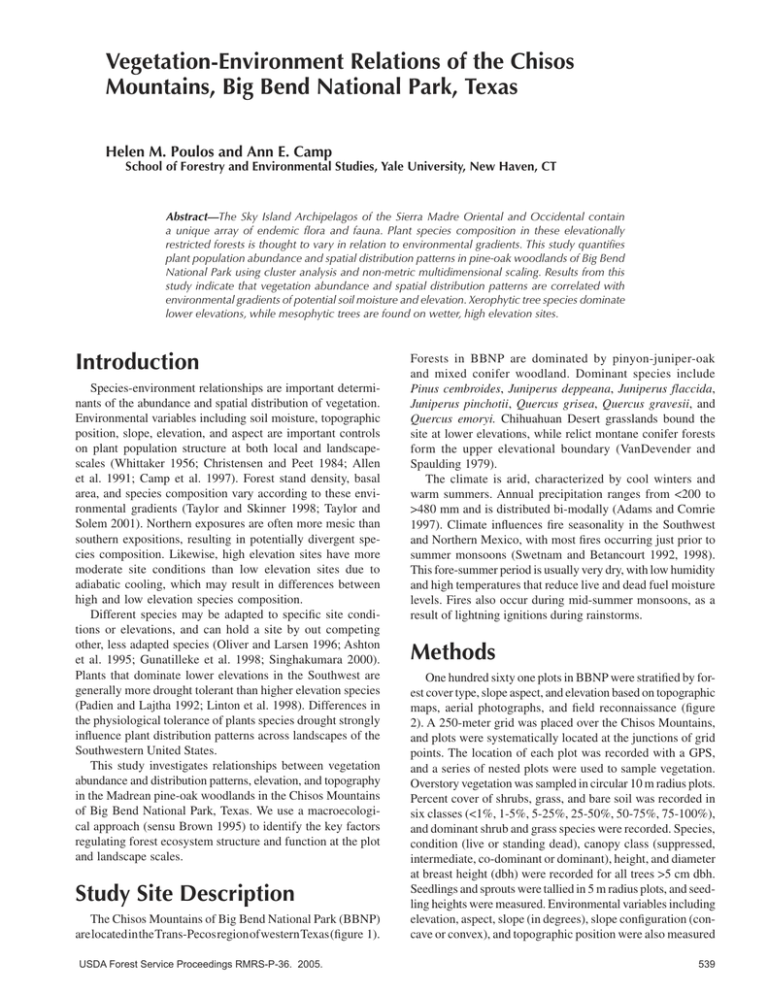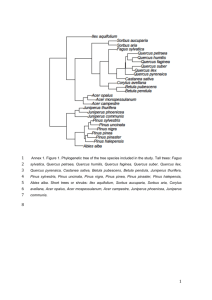Introduction
advertisement

Vegetation-Environment Relations of the Chisos Mountains, Big Bend National Park, Texas Helen M. Poulos and Ann E. Camp School of Forestry and Environmental Studies, Yale University, New Haven, CT Abstract—The Sky Island Archipelagos of the Sierra Madre Oriental and Occidental contain a unique array of endemic flora and fauna. Plant species composition in these elevationally restricted forests is thought to vary in relation to environmental gradients. This study quantifies plant population abundance and spatial distribution patterns in pine-oak woodlands of Big Bend National Park using cluster analysis and non-metric multidimensional scaling. Results from this study indicate that vegetation abundance and spatial distribution patterns are correlated with environmental gradients of potential soil moisture and elevation. Xerophytic tree species dominate lower elevations, while mesophytic trees are found on wetter, high elevation sites. Introduction Species-environment relationships are important determinants of the abundance and spatial distribution of vegetation. Environmental variables including soil moisture, topographic position, slope, elevation, and aspect are important controls on plant population structure at both local and landscapescales (Whittaker 1956; Christensen and Peet 1984; Allen et al. 1991; Camp et al. 1997). Forest stand density, basal area, and species composition vary according to these environmental gradients (Taylor and Skinner 1998; Taylor and Solem 2001). Northern exposures are often more mesic than southern expositions, resulting in potentially divergent species composition. Likewise, high elevation sites have more moderate site conditions than low elevation sites due to adiabatic cooling, which may result in differences between high and low elevation species composition. Different species may be adapted to specific site conditions or elevations, and can hold a site by out competing other, less adapted species (Oliver and Larsen 1996; Ashton et al. 1995; Gunatilleke et al. 1998; Singhakumara 2000). Plants that dominate lower elevations in the Southwest are generally more drought tolerant than higher elevation species (Padien and Lajtha 1992; Linton et al. 1998). Differences in the physiological tolerance of plants species drought strongly influence plant distribution patterns across landscapes of the Southwestern United States. This study investigates relationships between vegetation abundance and distribution patterns, elevation, and topography in the Madrean pine-oak woodlands in the Chisos Mountains of Big Bend National Park, Texas. We use a macroecological approach (sensu Brown 1995) to identify the key factors regulating forest ecosystem structure and function at the plot and landscape scales. Study Site Description The Chisos Mountains of Big Bend National Park (BBNP) are located in the Trans-Pecos region of western Texas (figure 1). USDA Forest Service Proceedings RMRS-P-36. 2005. Forests in BBNP are dominated by pinyon-juniper-oak and mixed conifer woodland. Dominant species include Pinus cembroides, Juniperus deppeana, Juniperus flaccida, Juniperus pinchotii, Quercus grisea, Quercus gravesii, and Quercus emoryi. Chihuahuan Desert grasslands bound the site at lower elevations, while relict montane conifer forests form the upper elevational boundary (VanDevender and Spaulding 1979). The climate is arid, characterized by cool winters and warm summers. Annual precipitation ranges from <200 to >480 mm and is distributed bi-modally (Adams and Comrie 1997). Climate influences fire seasonality in the Southwest and Northern Mexico, with most fires occurring just prior to summer monsoons (Swetnam and Betancourt 1992, 1998). This fore-summer period is usually very dry, with low humidity and high temperatures that reduce live and dead fuel moisture levels. Fires also occur during mid-summer monsoons, as a result of lightning ignitions during rainstorms. Methods One hundred sixty one plots in BBNP were stratified by forest cover type, slope aspect, and elevation based on topographic maps, aerial photographs, and field reconnaissance (figure 2). A 250-meter grid was placed over the Chisos Mountains, and plots were systematically located at the junctions of grid points. The location of each plot was recorded with a GPS, and a series of nested plots were used to sample vegetation. Overstory vegetation was sampled in circular 10 m radius plots. Percent cover of shrubs, grass, and bare soil was recorded in six classes (<1%, 1-5%, 5-25%, 25-50%, 50-75%, 75-100%), and dominant shrub and grass species were recorded. Species, condition (live or standing dead), canopy class (suppressed, intermediate, co-dominant or dominant), height, and diameter at breast height (dbh) were recorded for all trees >5 cm dbh. Seedlings and sprouts were tallied in 5 m radius plots, and seedling heights were measured. Environmental variables including elevation, aspect, slope (in degrees), slope configuration (concave or convex), and topographic position were also measured 539 Figure 1—Map of Big Bend National Park, Brewster County, Texas. at each plot. Slope contour, aspect, topographic position, and slope were used to generate a topographic relative moisture index (TRMI) that estimated potential soil moisture (Parker 1982). Aspect was used to calculate a heat load index using the formula (1-cos (θ – 45))/2 where θ = aspect in degrees east of true north (McCune and Grace 2002). Species Importance Values (IV) were calculated as the sum of relative basal area and relative density for each plot. We used Cluster Analysis to identify forest compositional groups. Clustering was performed using relative Euclidean distances and Ward’s method. We used Species Indicator Analysis to determine the number of clusters to retain. Differences between species composition groups were determined using Multi-Response Permutation Procedures (MRPP). Separation between cluster groups was assessed, and environmental gradient length was determined using Non-Metric Multidimensional Scaling (NMS). Pearson’s correlation coefficients were calculated between species axis scores and environmental variables to determine the relationship between species axis scores and the environmental variables. 540 Results Six species composition groups were determined from Cluster Analysis and Indicator Species Analysis (figure 3; table 1). Species composition groups were significantly different (p < 0.001) from each other according to Multiple Response Permutation Tests. Juniperus deppeana-Pinus cembroidesQuercus grisea stands are dominated by alligator juniper (J. deppeana), and contained pinyon pine (Pinus cembroides), gray oak (Q. grisea) associates. These stands dominate middle to high elevation sites of intermediate soil moisture. Quercus grisea-Pinus cembroides-Juniperus deppeana stands overlap in their distribution with Juniperus deppeana-Pinus cembroides-Quercus grisea, but are dominated by gray oak, and have pinyon pine and alligator juniper associates. Mesic woodland stands exist at higher elevations on moist sites, and are dominated by Quercus gravesii and Cupressus arizonica. They contain Arubutus xalapensis and Acer grandidentatum as understory associates. Other mesic species including Pinus ponderosa, Pseudotsuga menzesii, and Quercus muhlenbergii USDA Forest Service Proceedings RMRS-P-36. 2005. 900 450 0 900 Meters Figure 2—Sample plot locations in Big Bend National Park. USDA Forest Service Proceedings RMRS-P-36. 2005. 541 Figure 3—Nonmetric Muldimensional Scaling of Species importance values (n = 161) from Big Bend National Park. Species composition groups are derived from Cluster Analysis. The Nonmetric Multidimensional Scaling solution was achieved using a Detrended Correspondence Analysis starting configuration, relative Euclidean Distances, and a three-axis solution. are also found on restricted sites within this group. Juniperus flaccida-Pinus cembroides stands exist across a range of elevations and potential soil moistures. Weeping juniper (J. flaccida) is the dominant tree in this group, though pinyon pine is also a significant indicator species in this stand type. Juniperus pinchotii-Quercus grisea stands occupy middle elevation sites of low potential soil moisture. These stands exist at low elevations, and also within the higher elevation Blue Creek burn area where a high severity fire burned in 1988. Within the burn, there are large amounts of dead and downed pinyon pine that died in the Blue Creek Fire (personal observation). Quercus emoryi-Quercus turbinella stands are found on low elevation, dry sites with pinyon pine as a minor associate. The Non-metric Multidimensional Scaling of species importance values separated plots according to species composition, elevation, and potential soil moisture (figure 3; table 2). Axis 1 separated alligator juniper and gray oak from weeping juniper and Emory oak (Q. emoryi). Alligator juniper and gray oak are found on more mesic, high elevation sites, while the other two species exist at lower elevations on drier sites. Axis 2 separated alligator juniper and pinyon pine from red berry juniper (J. pinchotii) and gray oak. Gray oak and red berry juniper are found on drier sites than alligator juniper and gray oak. Axis 3 separated pinyon pine and gray oak from mesic tree species with high amounts of coarse woody debris. Pinyon pine and gray oak grow on more extreme sites than the species that are negatively correlated with this axis. Species negatively correlated with axis 3 exist in closed canopy forests that have greater amounts of overall biomass and downed coarse woody debris. 542 Conclusions Tree species abundance and distribution patterns in the Chisos Mountains of Big Bend National Park are correlated with elevation and potential soil moisture gradients. Aspect and heat load did not significantly predict species abundance or composition. These patterns correspond to the ecophysiological tolerance of tree species to drought (Padien and Lajtha 1992; Linton et al. 1998). Species tolerant of drought dominate lower elevations, while more mesophytic species dominate moist, high elevation sites. Studies on tree species water relations in BBNP could provide a mechanistic explanation for the observed abundance and distribution patterns of vegetation in BBNP. References Adams. D. K.; A. C. Comrie. 1997. The North American Monsoon. Bulletin of the American Meteorological Society 78(10): 21972213. Allen, R. B.; R. K. Peet; W. L. Baker. 1991. Gradient analysis of latitudinal variation in Southern Rocky Mountain forests. Journal of Biogeography 18: 123-139. Ashton, P. M. S.; C. V. S. Gunatilleke; I. A. U. N. Gunatilleke. 1995. Seedling survival and growth of 4 Shorea species in a Sri-Lankan Rain-Forest. Journal of Tropical Ecology 11: 262-279. Brown, J. H. 1995. Macroecology. Chicago: University of Chicago Press. Camp, A. E.; C. D. Oliver; P. F. Hessburg; R. L. Everett. 1997. Predicting late successional fire refugia pre-dating European settlement in the Wenatchee Mountains. Forest Ecology and Management 95: 63-77. USDA Forest Service Proceedings RMRS-P-36. 2005. Table 1—Results from Indicator Species analysis. * indicates significance of Monte Carlo permutation tests (* = p < 0.01, ** = p < 0.001). Significant indicator species were used to name species composition groups from Cluster Analysis. Species Acer grandidentata** Arbutus xalapensis** Cupressus arizonica* Fraxinus pensylvanica Fraxinus greggi Juniperus deppeana** Juniperus flaccida** Juniperus pinchotii** Pinus cembroides** Pinus ponderosa* Prunus serotina Pseudotsuga menzesii Quercus emoryi** Quercus gravesii** Quercus grisea** Quercus muhlenbergii Quercus pungens Quercus turbinella** 1 2 0 1 0 0 0 44 1 0 34 0 0 0 0 1 11 0 0 0 32 33 25 0 6 1 7 0 2 16 9 5 1 75 2 5 2 1 Cluster Group 3 4 0 0 0 0 0 2 64 0 20 0 0 0 0 2 9 0 4 0 0 0 0 7 2 1 3 0 10 0 0 0 87 2 0 0 0 93 5 6 0 0 0 0 0 0 0 94 4 0 0 0 0 0 24 0 0 0 0 0 0 0 0 16 6 0 15 0 0 0 0 1 39 0 0 1 Table 2—Pearson product moment correlation (n = 161) of species importance values, TRMI and elevation for axes 1, 2, and 3 of NMS for Big Bend National Park. Species Axis 1 Axis 2 Axis 3 Acer grandidentata Arbutus xalapensis Cupressus arizonica Juniperus deppeana Juniperus flaccida Juniperus pinchotii Pinus cembroides Pinus ponderosa Prunus serotina Pseudotsuga menzeisii Quercus emoryi Quercus gravesii Quercus grisea Quercus muhlenbergii Quercus pungens Quercus turbinella -0.078 0.059 -0.026 -0.493 0.245 0.129 -0.112 0.109 0.024 -0.037 0.771 0.161 -0.552 -0.007 -0.015 0.782 0.035 -0.102 -0.227 0.446 0.125 -0.418 0.614 -0.026 -0.042 -0.093 -0.029 -0.065 -0.641 -0.011 -0.203 -0.014 -0.428 -0.353 -0.364 0.031 -0.177 -0.007 0.677 -0.364 -0.254 -0.083 -0.089 -0.784 0.393 -0.239 -0.066 -0.081 Elevation TRMI -0.569 0.277 0.224 -0.265 0.322 -0.487 Christensen, N. L.; R. K. Peet. 1984. Convergence during secondary succession. Journal of Ecology 72: 25-36. Gunatilleke, C. V. S.; Gunatilleke, I. A. U. N.; Ashton, P. M. S.; Ashton, P. S. 1998. Seedling growth of Shorea (Dipterocarpaceae) across an elevational range in Southwest Sri Lanka. Journal of Tropical Ecology 14: 231-245. Linton, M. J.; J. S. Sperry; D. G. Williams. 1998. Limits to water transport in Juniperus osteosperma and Pinus edulis: implications for drought tolerance and regulation of transipiration. Functional Ecology 12: 906-911. Oliver, C. D.; B. C. Larson. 1996. Forest Stand Dynamics. New York: Wiley and Sons. Padien, D. J.; K. Lajtha. 1992. Plant spatial pattern and nutrient distribution in pinyon-juniper woodlands along an elevational USDA Forest Service Proceedings RMRS-P-36. 2005. gradient in northern New Mexico. International Journal of Plant Science 153(3): 425-433. Parker, A. J. 1982. The topographic relative moisture index: an approach to soil moisture assessment in mountain terrain. Physical Geography 3: 160-168. Singhakumara, B. M. P., Uduporuwa, R. S. J. P., Ashton, P. M. S. 2000. Soil seed banks in relation to light and topographic position of a hill dipterocarp forest in Sri Lanka. Biotropica 32 (1): 190-196. Swetnam, T. W.; J. L. Betancourt. 1992. Temporal patterns of El Niño/ Southern Oscillation-wildfire teleconnections in the Southwestern United States. In: H. F. Diaz; V. Markgraf, eds. El Niño: Historical and Paleoclimatic aspects of the Southern Oscillation. Cambridge: Cambridge University Press. 543 Swetnam, T. W.; J. L Betancourt. 1998. Mesoscale disturbance and ecological response to decadal climatic variability in the American Southwest. Journal of Climate 11: 3128-3147. Taylor, A. H.; Skinner, C. N. 1998. Fire history and landscape dynamics in a late successional reserve, Klamath Mountains, California, USA. Forest Ecology and Management 111: 285-301. Taylor, A. H.; M. N. Solem. 2001. Fire regimes and stand dynamics on an upper montane forest landscape in the Southern Cascades, Caribou Wilderness, USA. Journal of the Torrey Botanical Club 128: 350-361. VanDevender, T. R.; W. G. Spaulding. 1979. Development of vegetation and climate in the Southwestern United States. Science 2-4: 701-704. Whittaker, R. H. 1956. Vegetation of the Great Smoky Mountains. Ecological Monographs 21(1): 1-80. 544 USDA Forest Service Proceedings RMRS-P-36. 2005.


